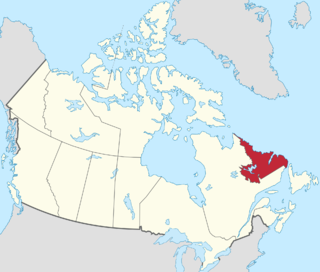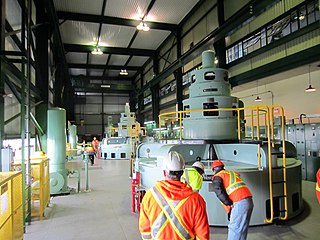
Labrador is a geographic and cultural region within the Canadian province of Newfoundland and Labrador. It is the primarily continental portion of the province and constitutes 71% of the province's area but is home to only 6% of its population. It is separated from the island of Newfoundland by the Strait of Belle Isle. It is the largest and northernmost geographical region in the four Atlantic provinces.

Daniel E. Williams is a Canadian politician, businessman, and lawyer who served as the ninth premier of Newfoundland and Labrador between November 6, 2003, and December 3, 2010.
Alfred Brian Peckford is a Canadian politician who served as the third premier of Newfoundland from March 26, 1979 to March 22, 1989. A member of the Progressive Conservative (PC) Party, Peckford was first elected as the Member of the House of Assembly (MHA) for Green Bay following the 1972 general election. He served as a cabinet minister in Frank Moores' government before he was elected as PC leader in 1979 following Moores' retirement.
In Canadian law, a reference question or reference case is a submission by the federal or a provincial government to the courts asking for an advisory opinion on a major legal issue. Typically the question concerns the constitutionality of legislation.
Twin Falls is the site of a hydroelectric power station developed by the British Newfoundland Development Corporation (Brinco) to deliver power to mining operations in Labrador City and Wabush.
Newfoundland and Labrador Hydro, commonly known as Hydro, is a provincial Crown corporation that generates and delivers electricity for Newfoundland and Labrador, as well as portions of Quebec and the north-eastern areas of the United States. Between 2007 and 2021, NL Hydro was a subsidiary of the provincial Crown-owned energy holding company Nalcor Energy.
The British Newfoundland Development Corporation, or BRINCO, was incorporated by a consortium of British companies in 1953, which undertook industrial development opportunities in the province of Newfoundland and Labrador, Canada. The company was involved in the construction of the Churchill Falls Generating Station.

The electricity sector in Canada has played a significant role in the economic and political life of the country since the late 19th century. The sector is organized along provincial and territorial lines. In a majority of provinces, large government-owned integrated public utilities play a leading role in the generation, transmission, and distribution of electricity. Ontario and Alberta have created electricity markets in the last decade to increase investment and competition in this sector of the economy.

Reference Re Upper Churchill Water Rights Reversion Act (Nfld) [1984] 1 S.C.R. 297 is a famous constitutional reference question put to the Supreme Court of Canada. The Court found that legislation passed by the government of Newfoundland to take back water rights contracted out to the province of Quebec was unconstitutional. The decision had a huge impact on both provinces, as the Churchill Falls generating station is one of the biggest producers of hydro-electric power in the region and the agreement guarantees Quebec will receive a majority of the revenue from the Falls until 2034.
Nova Scotia Power Inc. is a vertically integrated electric utility in Nova Scotia, Canada. It is privately owned by Emera and regulated by the provincial government via the Nova Scotia Utility and Review Board (NSUARB). Nova Scotia Power Inc provides electricity to 520,000 residential, commercial and industrial customers in Nova Scotia.

Nalcor Energy is a defunct provincial energy corporation which was headquartered in St. John's, Newfoundland and Labrador. A provincial Crown corporation under the Government of Newfoundland and Labrador, Nalcor Energy was created in 2007 to manage the province's energy resources. The company has distinct business lines comprising Newfoundland and Labrador Hydro, the Churchill Falls Generating Station, the Lower Churchill Project, energy marketing, oil and gas development, and The Bull Arm Fabrication Site.
Hydro-Québec is a government-owned public utility established in 1944 by the Government of Quebec. The company is in charge of the generation, transmission and distribution of electricity across Quebec. Its head office is located in Montreal.

The Churchill Falls Generating Station is a hydroelectric underground power station in Labrador. At 5,428 MW, it is the sixteenth largest in the world, and the second-largest in Canada, after the Robert-Bourassa generating station in northwestern Quebec.
The Muskrat Falls Generating Station is a hydroelectric generating station in the Labrador region of Newfoundland and Labrador, Canada. It comprises part of the remaining 35 per cent of the Churchill River that was not developed by the Churchill Falls Generating Station. The station at Muskrat Falls has a capacity of over 824 MW and provides 4.5 TWh of electricity per year.

The Menihek Hydroelectric Generating Station is a conventional hydroelectric generating station at Menihek Lake in Labrador. The dam and powerhouse are located in the Canadian province of Newfoundland and Labrador, 40 km (25 mi) south of the isolated town of Schefferville, Quebec and two First Nations communities: Matimekosh-Lac-John and Kawawachikamach. The generating station, two 69 kV power lines and the distribution networks in each community form an independent electricity network, off the main North American grid.
Central Labrador is the most populous region of Labrador, Canada, that extends from the shores of Lake Melville into the interior. It is also home to Happy Valley – Goose Bay, the largest community in Labrador.

The border between the province of Quebec and the province of Newfoundland and Labrador is the longest interprovincial border in Canada. It stretches for more than 3,500 kilometres (2,200 mi) on land, and, according to both provincial governments, also contains a maritime part. Starting from the north, the border follows the Laurentian Divide on the Labrador Peninsula for the majority of the border's length, then follows the divide between the Côte-Nord-Gaspé and Newfoundland-Labrador drainage basins as far as Brûlé Lake, after which it goes along the Romaine River downstream to the 52nd parallel, which it follows east to its southeastern terminus at Blanc-Sablon.








